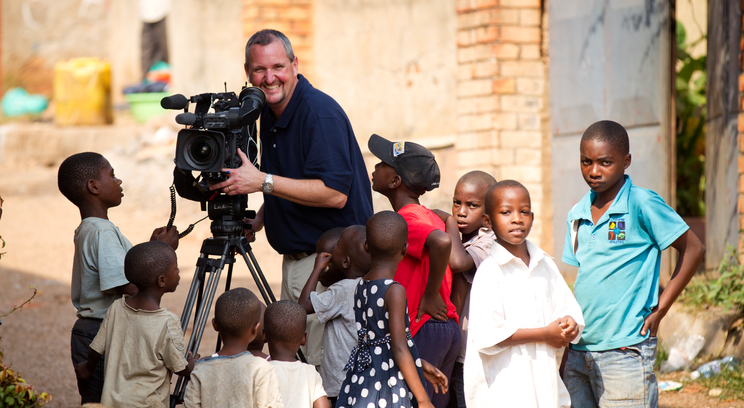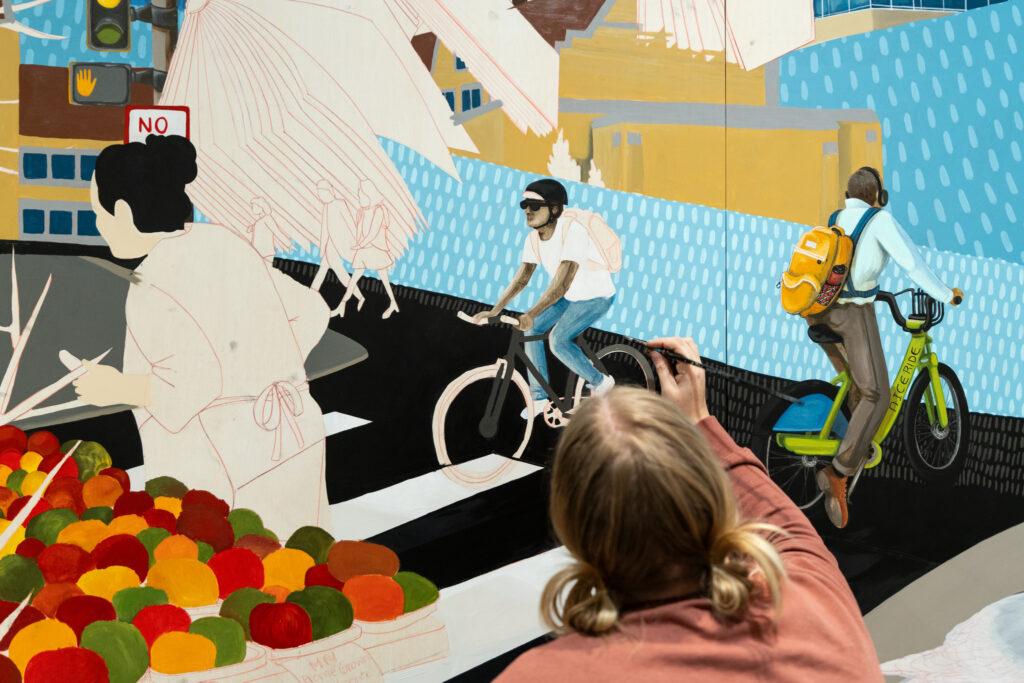KITEMBE, UGANDA - It is 8 o’clock at night, and the trading center has come alive ... with lights.
People wander down the gravel road and dirt paths flanking the brick buildings and stone or mud huts that serve as storefronts and homes. They pause to talk and to laugh. Dozens gather under two wooden canopies to watch young men shoot pool, and there is good-natured hooting and hollering as someone sinks - or misses - a shot ... under the lights.
Nearby, Milton Muhaivwe stands in his doorway and surveys the scene. The 54-year-old man was born across the road and has lived in Kitembe his entire life. Like many others, he is a subsistence farmer who grows matoke and beans, and he sells a few items in his storefront, with a bed in the back for his wife and their baby girl. He only nods when asked about the lights.
A few doors away, Betsy Katushabe cradles her baby boy while grabbing a bottle of water for a visitor. The 25-year-old woman has two other children and sells bananas, eggs, onions and other staples in her storefront while living in back. She, too, is excited about the lights.
Lights ... We take them for granted. Flip a switch, there is light. Walk into a room, a light goes on. When dusk falls, streetlights automatically shine.
Not in Kitembe, a village near the equator and the Rwanda border, about 180 miles southwest of Kampala. The village encompasses a hilly region of several square miles, and in the valley is the trading center, where for centuries there have been no lights. As the sun would fall in the western sky early every evening, darkness would envelop Kitembe for 12 hours.
And that bothered Brian Osende. He decided to do something about it.
The St. Thomas graduate, with bachelor’s and master’s degrees in mechanical engineering, was raised in Kampala and moved to Minnesota in 2005. His mom grew up in Kitembe and her parents still live there. Only a handful of people can afford to pay for the electricity provided by power lines that run through the countryside, so the village has gone without power.
"As a kid, I was always tinkering," said Osende, 25, a standards engineer for Xcel Energy. "I figured out how electricity was made when I was in grade 5. I made a mini-generator, and I always had this dream to bring power to my mom’s village."
Muhaivwe would burn wood outdoors for light or use kerosene lamps - if he could afford the kerosene - but those bothered his breathing. So he went without light.
"It’s hard to describe," said Dr. John Abraham, a professor in the St. Thomas School of Engineering, "but think of it this way: when the sun goes down, the light ends and you go to bed."
"When it gets dark over there, it’s really, really dark!" Osende said. He recalled a night when "it was so dark I could not see the road. I would pause on the road and wait for lightning, and when lightning struck I would see the road. Things like that stuck with me."
His mom, Dorothy Michori, smiles when she recalls her son’s dream.
"He started talking about it when he was young," Michori said. "He would say, ‘Maybe we can create our own electricity!’ I would laugh at him and say, ‘How are you going to do it?’ I shut him up and told him to stop talking like that."
Osende graduated from Woodbury High School, where he knew Chris Dease, an art teacher and the sister-in-law of Father Dennis Dease, president of St. Thomas. He persuaded Osende to enroll at St. Thomas, and Osende rekindled his dream of bringing lights to Kitembe.
Abraham and faculty colleague Dr. Greg Mowry encouraged Osende to develop a proposal for his master’s degree project. He made trips to Kitembe in 2007 and 2009 to do research; secured funds from Abraham, Dease and Xcel, where he had an internship; and recruited 15 people to participate in the 2011 January Term project.
Osende’s family still had its doubts.
"My mom thought Brian was crazy," Michori said. "I told her, ‘Mom, don’t ask.’ He knew what he was doing. He was committed. He said, ‘I can do this. I know it can be done.’ He had so much confidence. Maybe too much confidence!"
Osende traveled to Kitembe in December 2010 to buy $7,000 in equipment and supplies. The St. Thomas contingent, including Abraham, Mowry and five students, arrived in early January and finished the project in less than two weeks, although not without some drama.
"The local Army chief came by and thought we were stealing power," Abraham said. "He had a belligerent, antagonistic attitude, but I showed him how the solar panels worked and an hour later he became one of our biggest supporters. We had him provide security for us."
Here is how the system works: Independent power lines extend in two directions along a 300-meter path, and originate from a centrally located array of eight 175-watt solar panels that store energy in four 12-volt batteries. Up to 10,000 W-hours can be generated from each full day of sunlight; light bulbs collectively require 4,000 W-hours and four cell phone and battery-charging stations require 1,000 W-hours.
The power lines proved to be "immense and the most time-consuming issue," Osende said. "When I originally bought the equipment, I had 200 meters of wire. By the end of the project, we used 2,000 meters. I guess I didn’t plan very well!"
The crew installed 93 seven-watt fluorescent bulbs in 46 houses, a school and two medical clinics and erected eight external "security" lights - what we think of as streetlights.
Villagers’ curiosity evolved into interest and then excitement in the three years between Osende’s first research visit and his team’s arrival, "and they were more than willing to help," he said. They offered land for the solar array station, brought food from their gardens and became true believers, "and that meant a lot to me ... that I could achieve this dream."
When the day came to flip the switch for a test, nothing happened.
"I was so tense," Osende said. "I sat down and had to think. It was such a simple thing but I couldn’t see it. When I looked at the schematic on how the inverters were wired, that’s when it occurred to me: I had designed a 24-volt system and I was trying to use a 12-volt system."
He made the fix and the power went on.
"It was so big," Osende said, gushing in stream-of-conscious superlatives. "Everybody was clapping - the volunteers, the villagers, everybody. We let the system charge up all night ... and the next night at 7 the power went on ... I have never been so happy in my life ... Up to then, it had not sunk in that it would happen. ... Was I dreaming? I guess it really happened. It was really, really something!"
Osende returned to Uganda in May 2011, after graduation, to check on the project and was amazed at the transformation in the trading center. It was vibrant at night, and he found a makeshift "house" had been constructed between two other houses - and around an external security light. He learned that Janet Musevini, the wife of Uganda’s president, had visited Kitembe.
Then came the news in September that lightning had struck the solar arrays and knocked out the power. Osende’s grandmother Sarah, 85, a former teacher, was blunt with him:
"She said, ‘You introduced people to power, and now they can’t live without it. They keep bugging me every day: when is it going to be back on?’"
Osende met with Abraham, who joined with Dease to cover the $6,000 repair costs. Osende’s cousin, Denis Bazalirwe, who will begin master’s degree studies in software engineering this fall at St. Thomas, traveled from Kampala to Kitembe to assess the problem. He returned a dozen times to coordinate repairs, including installation of a lightning mast, and collaborated by phone and email with Osende and Abraham. The system was fixed last Jan. 14.
Four days later, a St. Thomas group arrived to document the project for this magazine. Osende couldn’t make the trip, but his mom did, as did Molly Rolfsmeier. She is Abraham’s wife (and he joined her the following week in Kampala to go through a monthlong process to adopt Avory Nanyunja Abraham, a two-year-old Ugandan girl).
Villagers greeted the St. Thomas group with open arms - it’s rare that a muzungu (white person) travels through the area - and a party emceed by Robert Kayeyera, a Kitembe native who works for the president of Uganda and assisted with the repairs. Four hundred people jammed into a town square-like area where the solar array is located for speeches, music and dancing by the Kitembe Cultural Drama Group. This writer, after thanking the villagers for their warm hospitality, had the privilege of flipping the switch ... and the power was on!
As satisfied as Osende is, he wants to do more, and he is not alone. Michori, his mom, and the Caring Hearts organization in Kitembe are raising funds to build a health care clinic up the hill from the trading center. Dr. Simon Emms, a biology professor at St. Thomas, hopes to find funding to bring lights to other Ugandan villages and demonstrate the university’s commitment to sustainability and carbon neutrality.
Osende views the Kitembe project as proof that "you don’t need a million dollars" to bring light and happiness to others, and he always thinks about it when he goes into a dark room at work.
"The motion sensor that turns on lights here reminds me of the project," he said. "It brings back memories of how, at the end, we saw the lights come on. It gives me joy. It makes me believe that at least one of my biggest dreams, that the reason I went to school, that the reason I became an engineer, that the reason I actually live, is being achieved - to make the world a better place."
And Osende never will forget what it was like that first night 17 months ago, when his St. Thomas team walked through the dark to its lodging a mile away.
"You get on top of the hill and you can see the trading center," he said. "All this darkness around us and this stream of lights along the road that showed the trading center. That was something else. That was something I will never forget."
Read more from St. Thomas magazine







